Lattice Strain Evolutions in Ni-W Alloys during a Tensile Test Combined with Synchrotron X-ray Diffraction
Abstract
1. Introduction
2. Materials and Methods
3. Results and Discussion
- (i)
- From 0 MPa to 75 MPa (for the Ni) and 180 MPa (for the Ni-10W), the lattice strains increase linearly with the applied stresses. This is in accordance with the elastic domain at the macroscopic scale highlighted in Figure 2.
- (ii)
- At some points, from 75 MPa to 170 MPa (for the bulk Ni) and from 180 MPa to 290 MPa (for the Ni-10W alloy), a sudden change in lattice strain occurs.
- (iii)
- From 170 MPa to 350 MPa (for the bulk Ni) and from 290 to 350 MPa (for the Ni-10W alloy), a very slight variation of the crystal lattice occurs.
- (iv)
- The last points are associated with a sharper increase, in absolute value, of the crystal lattices, most probably due to the sample’s striction.
4. Conclusions
Author Contributions
Funding
Acknowledgments
Conflicts of Interest
References
- Genç, A.; Kaya, P.; Ayas, E.; Ovecoglu, M.L.; Turan, S. Microstructural evolution of mechanically alloyed and spark plasma sintered Ni-W alloy matrix composites. J. Alloys Compd. 2013, 571, 159–167. [Google Scholar] [CrossRef]
- Elias, L.; Hegde, A.C. Effect of magnetic field on corrosion protection efficacy of Ni-W alloy coatings. J. Alloys Compd. 2017, 712, 618–626. [Google Scholar] [CrossRef]
- Yu, J.; Wang, Y.; Zhao, X.; Li, Q.; Qiao, Q.; Zhao, J.; Zhai, S. Wear resistance of ni-based alloy coatings. Adv. Mater. Sci. Eng. 2019, 2019, 1–7. [Google Scholar] [CrossRef]
- Chianpairot, A.; Lothongkum, G.; Schuh, C.A.; Boonyongmaneerat, Y. Corrosion of nanocrystalline Ni-W alloys in alkaline and acidic 3.5wt.% NaCl solutions. Corros. Sci. 2011, 53, 1066–1071. [Google Scholar] [CrossRef]
- Druga, J.; Kašiarová, M.; Dobročka, E.; Zemanová, M. Corrosion and tribological properties of nanocrystalline pulse electrodeposited Ni–W alloy coatings. Trans. Inst. Met. Finish. 2017, 95, 39–45. [Google Scholar] [CrossRef]
- Sriraman, K.R.; Ganesh Sundara Raman, S.; Seshadri, S.K. Corrosion behaviour of electrodeposited nanocrystalline Ni-W and Ni-Fe-W alloys. Mater. Sci. Eng. A 2007, 460–461, 39–45. [Google Scholar] [CrossRef]
- Sadat, T.; Dirras, G.; Tingaud, D.; Ota, M.; Chauveau, T.; Faurie, D.; Vajpai, S.; Ameyama, K. Bulk Ni-W alloys with a composite-like microstructure processed by spark plasma sintering: Microstructure and mechanical properties. Mater. Des. 2016, 89, 1181–1190. [Google Scholar] [CrossRef]
- Iwasaki, H.; Higashi, K.; Nieh, T.G. Tensile deformation and microstructure of a nanocrystalline Ni-W alloy produced by electrodeposition. Scr. Mater. 2004, 50, 395–399. [Google Scholar] [CrossRef]
- Jinlong, L.; Zhuqing, W.; Tongxiang, L.; Suzuki, K.; Hideo, M. Effect of tungsten on microstructures of annealed electrodeposited Ni-W alloy and its corrosion resistance. Surf. Coat. Technol. 2018, 337, 516–524. [Google Scholar] [CrossRef]
- Indyka, P.; Beltowska-Lehman, E.; Tarkowski, L.; Bigos, A.; García-Lecina, E. Structure characterization of nanocrystalline Ni-W alloys obtained by electrodeposition. J. Alloys Compd. 2014, 590, 75–79. [Google Scholar] [CrossRef]
- Lee, S.; Choi, M.; Park, S.; Jung, H.; Yoo, B. Mechanical properties of electrodeposited Ni-W thin films with alternate W-Rich and W-Poor multilayers. Electrochim. Acta 2015, 153, 225–231. [Google Scholar] [CrossRef]
- Nasu, T.; Sakurai, M.; Kamiyama, T.; Usuki, T.; Uemura, O.; Tokumitsu, K.; Yamasaki, T. Structural comparison of M-W (M = Fe, Ni) alloys produced by electrodeposition and mechanical alloying. Mater. Sci. Eng. A 2004, 375–377, 163–170. [Google Scholar] [CrossRef]
- Argañaraz, M.P.Q.; Ribotta, S.B.; Folquer, M.E.; Zelaya, E.; Llorente, C.; Ramallo-López, J.M.; Benítez, G.; Rubert, A.; Gassa, L.M.; Vela, M.E.; et al. The chemistry and structure of nickel-tungsten coatings obtained by pulse galvanostatic electrodeposition. Electrochim. Acta 2012, 72, 87–93. [Google Scholar] [CrossRef]
- Schloßmacher, P.; Yamasaki, T. Structural analysis of electroplated amorphous-nanocrystalline Ni-W. Microchim. Acta 2000, 313, 309–313. [Google Scholar] [CrossRef]
- Schuh, C.A.; Nieh, T.G.; Iwasaki, H. The effect of solid solution W additions on the mechanical properties of nanocrystalline Ni. Acta Mater. 2003, 51, 431–443. [Google Scholar] [CrossRef]
- Ong, C.Y.A.; Blackwood, D.J.; Li, Y. The effects of W content on solid-solution strengthening and the critical Hall-Petch grain size in Ni-W alloy. Surf. Coat. Technol. 2019, 357, 23–27. [Google Scholar] [CrossRef]
- Zhu, L.; Younes, O.; Ashkenasy, N.; Shacham-Diamand, Y.; Gileadi, E. STM/AFM studies of the evolution of morphology of electroplated Ni/W alloys. Appl. Surf. Sci. 2002, 200, 1–14. [Google Scholar] [CrossRef]
- Kurz, S.J.B.; Ensslen, C.; Welzel, U.; Leineweber, A.; Mittemeijer, E.J. The thermal stability of Ni-Mo and Ni-W thin films: Solute segregation and planar faults. Scr. Mater. 2013, 69, 65–68. [Google Scholar] [CrossRef]
- Genç, A.; Oveçoglu, M.L.; Baydogan, M.; Turan, S. Fabrication and characterization of Ni-W solid solution alloys via mechanical alloying and pressureless sintering. Mater. Des. 2012, 42, 495–504. [Google Scholar] [CrossRef]
- Na, H.; Park, J.W.; Choi, H.; Cho, Y.S. Radio frequency thermal plasma-processed Ni-W nanostructures for printable microcircuit electrodes. Mater. Des. 2020, 191, 108590. [Google Scholar] [CrossRef]
- Cao, W.; Marvel, C.; Yin, D.; Zhang, Y.; Cantwell, P.; Harmer, M.P.; Luo, J.; Vinci, R.P. Correlations between microstructure, fracture morphology, and fracture toughness of nanocrystalline Ni-W alloys. Scr. Mater. 2016, 113, 84–88. [Google Scholar] [CrossRef]
- Mi, S. Processing, structure and properties of Ni-W alloys fabricated by mechanical alloying and hot-isostatic pressing. Scr. Mater. 1998, 38, 637–644. [Google Scholar] [CrossRef]
- Genç, A.; Lütfi Öveçoglu, M. Characterization investigations during mechanical alloying and sintering of Ni-W solid solution alloys dispersed with WC and Y2O3 particles. J. Alloys Compd. 2010, 508, 162–171. [Google Scholar] [CrossRef]
- Vegard, V.L. Die konstitution der mischkristalle und die raumffillung der atome. J. Mater. Sci. 1921, 1, 79–90. [Google Scholar] [CrossRef]
- Genç, A.; Ayas, E.; Öveçoglu, M.L.; Turan, S. Fabrication of in situ Ni(W)-WC nano composites via mechanical alloying and spark plasma sintering. J. Alloys Compd. 2012, 542, 97–104. [Google Scholar] [CrossRef]
- Sadat, T.; Hocini, A.; Lilensten, L.; Faurie, D.; Tingaud, D.; Dirras, G. Data on the impact of increasing the W amount on the mass density and compressive properties of Ni-W alloys processed by spark plasma sintering. Data Br. 2016, 7, 1405–1408. [Google Scholar] [CrossRef]
- Sadat, T.; Faurie, D.; Tingaud, D.; Mocuta, C.; Thiaudière, D.; Dirras, G. Fracture behavior of Ni-W alloy probed by in situ synchrotron X-ray diffraction. Mater. Lett. 2019, 239, 116–119. [Google Scholar] [CrossRef]
- Malard, B.; De Geuser, F.; Deschamps, A. Microstructure distribution in an AA2050 T34 friction stir weld and its evolution during post-welding heat treatment. Acta Mater. 2015, 101, 90–100. [Google Scholar] [CrossRef]
- Wang, B.; Tan, D.; Lee, T.L.; Khong, J.C.; Wang, F.; Eskin, D.; Connolley, T.; Fezzaa, K.; Mi, J. Ultrafast synchrotron X-ray imaging studies of microstructure fragmentation in solidification under ultrasound. Acta Mater. 2018, 144, 505–515. [Google Scholar] [CrossRef]
- Callegari, B.; Oliveira, J.P.; Aristizabal, K.; Coelho, R.S.; Brito, P.P.; Wu, L.; Schell, N.; Soldera, F.A.; Mücklich, F.; Pinto, H.C. In-situ synchrotron radiation study of the aging response of Ti-6Al-4V alloy with different starting microstructures. Mater. Charact. 2020, 165, 110400. [Google Scholar] [CrossRef]
- Neil, C.J.; Wollmershauser, J.A.; Clausen, B.; Tomé, C.N.; Agnew, S.R. Modeling lattice strain evolution at finite strains and experimental verification for copper and stainless steel using in situ neutron diffraction. Int. J. Plast. 2010, 26, 1772–1791. [Google Scholar] [CrossRef]
- Clausen, B.; Lorentzen, T.; Leffers, T. Self-consistent modeling of the plastic deformation of f.c.c polycristals and its implications for diffraction measurements of internal stresses. Acta Mater. 1998, 9, 3087–3098. [Google Scholar] [CrossRef]
- Dutel, G.D.; Tingaud, D.; Langlois, P.; Dirras, G. Nickel with multimodal grain size distribution achieved by SPS: Microstructure and mechanical properties. J. Mater. Sci. 2012, 47, 7926–7931. [Google Scholar] [CrossRef]
- Fan, G.J.; Li, L.; Yang, B.; Choo, H.; Liaw, P.K.; Saleh, T.A.; Clausen, B.; Brown, D.W. In situ neutron-diffraction study of tensile deformation of a bulk nanocrystalline alloy. Mater. Sci. Eng. A 2009, 506, 187–190. [Google Scholar] [CrossRef]
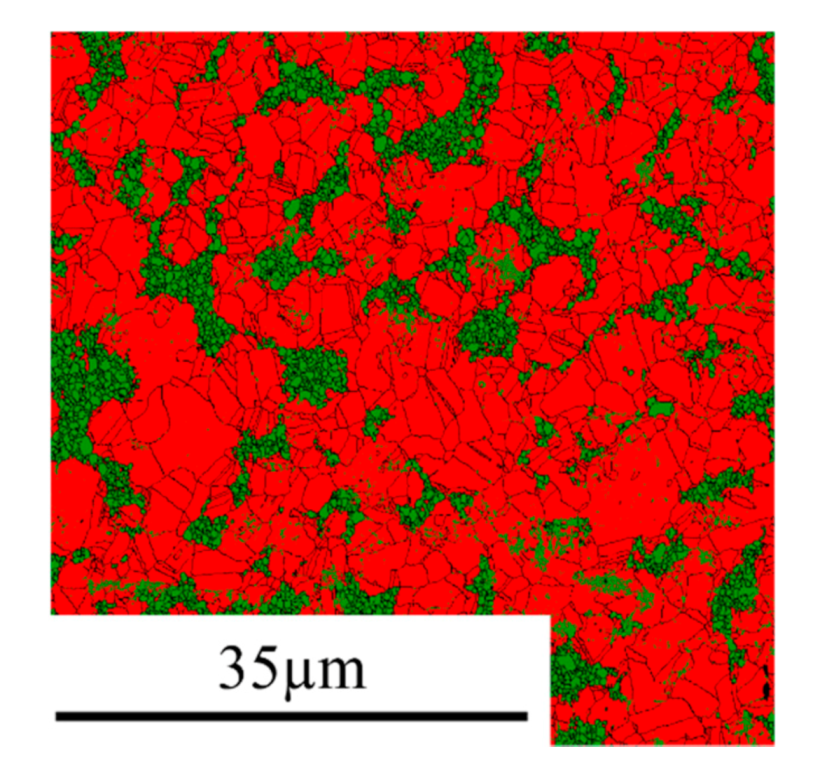

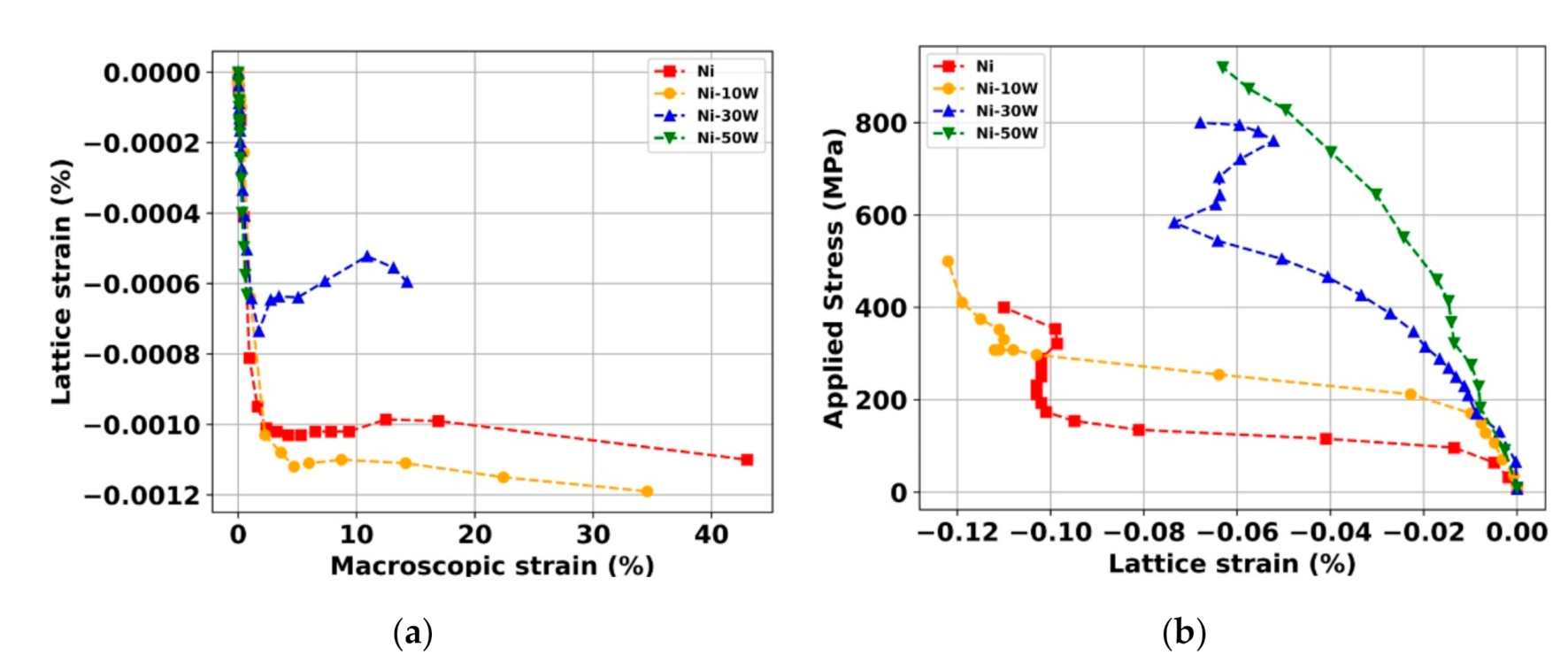
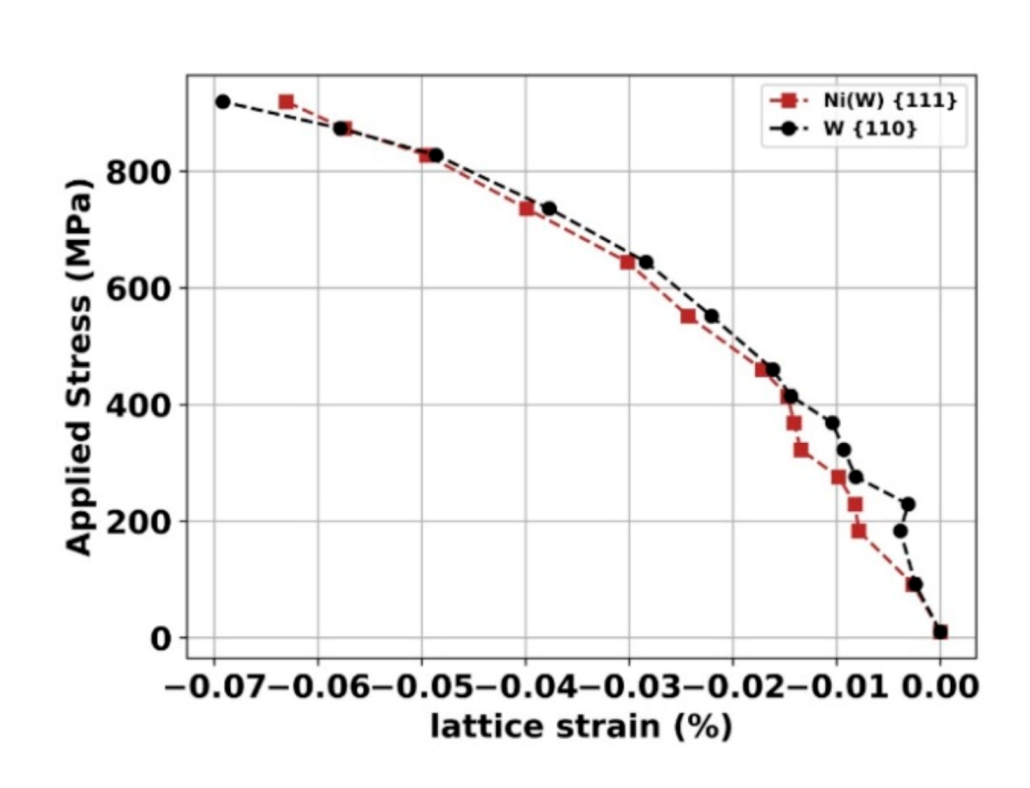
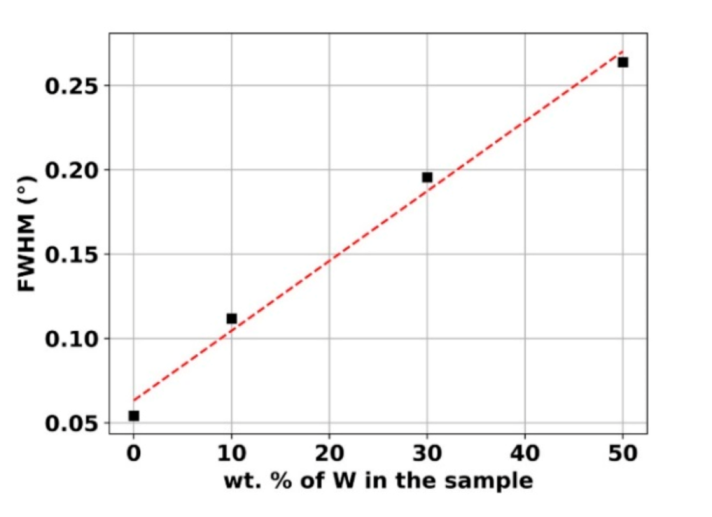
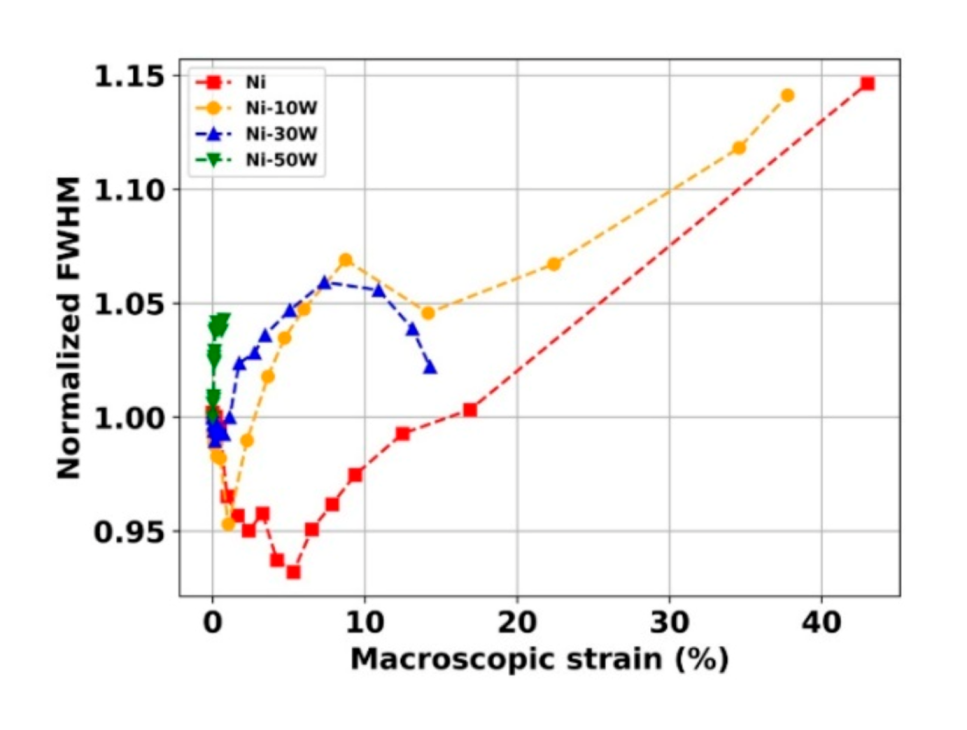
© 2020 by the authors. Licensee MDPI, Basel, Switzerland. This article is an open access article distributed under the terms and conditions of the Creative Commons Attribution (CC BY) license (http://creativecommons.org/licenses/by/4.0/).
Share and Cite
Sadat, T.; Faurie, D.; Thiaudière, D.; Mocuta, C.; Tingaud, D.; Dirras, G. Lattice Strain Evolutions in Ni-W Alloys during a Tensile Test Combined with Synchrotron X-ray Diffraction. Materials 2020, 13, 4027. https://doi.org/10.3390/ma13184027
Sadat T, Faurie D, Thiaudière D, Mocuta C, Tingaud D, Dirras G. Lattice Strain Evolutions in Ni-W Alloys during a Tensile Test Combined with Synchrotron X-ray Diffraction. Materials. 2020; 13(18):4027. https://doi.org/10.3390/ma13184027
Chicago/Turabian StyleSadat, Tarik, Damien Faurie, Dominique Thiaudière, Cristian Mocuta, David Tingaud, and Guy Dirras. 2020. "Lattice Strain Evolutions in Ni-W Alloys during a Tensile Test Combined with Synchrotron X-ray Diffraction" Materials 13, no. 18: 4027. https://doi.org/10.3390/ma13184027
APA StyleSadat, T., Faurie, D., Thiaudière, D., Mocuta, C., Tingaud, D., & Dirras, G. (2020). Lattice Strain Evolutions in Ni-W Alloys during a Tensile Test Combined with Synchrotron X-ray Diffraction. Materials, 13(18), 4027. https://doi.org/10.3390/ma13184027




